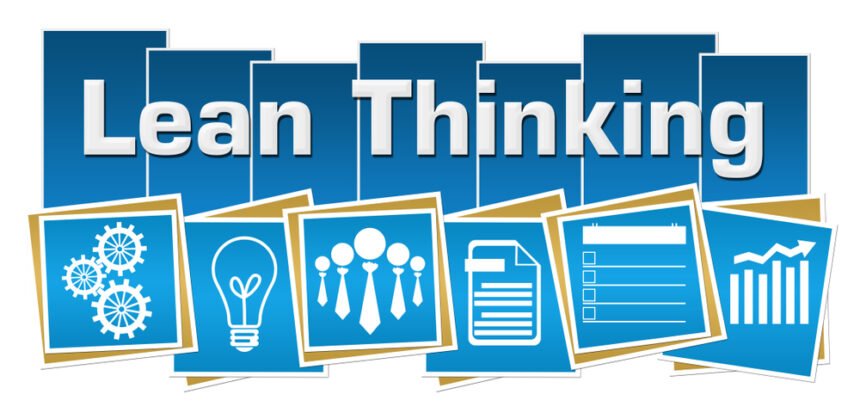Data-driven decision-making has become a major element of modern business. A growing number of businesses use big data technology to optimize efficiency. However, companies that have a formal data strategy are still in the minority. Only 32% of executives have officially laid out a data strategy to drive their organization.
Furthermore, only 13% of companies are actually delivering on their data strategy. Part of the reason is that they focus almost entirely on the technology itself without a clear plan for leveraging it effectively.
One of the ways that smart business leaders can create successful data strategies is to utilize lean thinking. Keep reading to learn how to combine these two initiatives.
Lean Thinking and Big Data Can Be Merged for Superior Decision-Making
For CEOs and company managers, it is crucial not to waste time and resources on tasks that do not make a significant contribution to the company, but instead are a waste. However, thanks to contributions from the Professional Master’s Degree Executive MBA area, systems have been created that minimize waste and at the same time maximize useful and beneficial results.
It is a lot easier to get the most bang for your buck with time and financial resources if you know how to take advantage of data analytics tools. A lot of analytics tools make it easier to monitor the performance of various strategies, so companies can use their resources more wisely.
The insights derived from data analytics tools allows them to avoid wasting time on tasks that don’t pay real dividends. This illustrates the benefits of combining big data and lean thinking.
While there are various interpretations or models to address such problems, Lean Thinking can contribute to the implementation of more optimal projects for a business. Keep reading to learn more about lean thinking and we will follow up on the ways to combine it with data analytics below.
What is Lean Thinking?
Creating value and improving efficiency and productivity at work, in order to reduce costs and waste is what Lean Thinking methodology is all about, i.e., it means that everything that is only inoperative for a business is set aside, leaving processes that have as objective the continuous improvement.
With the purpose of achieving contributions that represent greater value using fewer resources and time, a series of methods and tools are applied that allows the company to manage in a more effective way. Increasing the performance of the budget and the efficiency of automatic operations, and thus, increasing the production process, delivering quality products and services to the clients in the minimum amount of time possible.
Implementing Lean methodology
Within the Lean Thinking methodology, there are five essential components:
- Defining value: The value of the product will be defined by the number of customers who are interested in acquiring it, therefore, there must be a balance between price and the work behind the product or service, as well as satisfying the customer’s need.
- Determining the Value Stream: To identify where the points are generating value and what actions are merely wasteful; so, maintaining production with only the necessary use of resources and without sacrificing quality must be present.
Creating a map, a scheme or a software will allow for quicker identification of this.
- Creating flow: The flow of all remaining stages of the life cycle should be executed as fluid as possible. Therefore, it must be verified which sequences add value and which are dispensable.
- Establishing pull: It minimizes inventory and work-in-progress items as much as possible. Everything produced and spent and the amount of product generated should be in accordance with the customer’s demands, which ensures that production is streamlined and lean.
- Pursuing perfection: Excellence is paramount, which should not be lost sight of, and therefore, if continuous evaluation is relevant in various steps, such as waste generation and looking for opportunities for advancement in order to have continuous improvement, this should be done, and thus, achieve efficient results, depending on the trends and how this affects business.
Advantages in applying Lean Thinking
Finally, applying this methodology brings with it a host of advantages for companies:
- By bringing products to market in the shortest possible time, more resources and time are available to improve the product, thus meeting the needs and expectations of the public and strengthening loyalty.
- By having a visualisation of what generates profits and losses, the risk is lower because decisions are based on data and not assumptions. These decisions are better informed and therefore less prone to error.
- There is an increase in commercial workload which means immediate availability of products, as well as a reduction in defective items or downtime, minimising waste and overproduction, saving inventory management.
- All employees have the opportunity to participate in the whole process and the failure rate is reduced. This influences the motivation of the team and, consequently, their productivity. In addition, there will be a better working atmosphere, which is essential for the smooth running and flow of daily tasks.
Lean Thinking will not only save time and money, on the other hand, this saving can be derived to other sectors or personnel that need improvement, therefore, investing resources in other aspects will allow the most favorable and rapid development of the company.
How Can You Use Lean Thinking with Big Data?
There are also a number of ways that you can use big data technology to improve your lean decision-making strategies. Some of the options are listed below.
Determine the Types of Products that Actually Sell
You have probably had times when you spent weeks developing new products for your organization, only to witness that nobody ever wanted to purchase them. The good news is that data analytics tools help companies monitor sales of different products, so they can focus on developing those that are likely to sell. Many data-driven companies are using QR codes to track sales. This data doesn’t just help with inventory management. It also helps companies invest their R&D resources wisely and keeps them from wasting energy thinking of product ideas that will never sell.
Identify Tasks that Don’t Translate to Higher Productivity
You will also want to make sure that the tasks you and your employees are working on will actually lead to higher productivity. A number of analytics tools like GetApp and Monday.com help companies assess the tasks that employees are performing and determine the value they are adding to the organization.
Monitor Markets for Profitability
Many companies spend a lot of time and resources brainstorming strategies to scale into new markets. They might want to conquer the markets of new countries or expand into new demographics.
Data analytics technology is able to help them determine the profitability of the markets that they have focused on so far. They can use this data to decide which markets to ignore, so they don’t waste time thinking of new strategies that might not lead to higher profits.
Lead Decision Thinking and Big Data Are Invaluable to Modern Businesses
Ninety-one percent of companies feel that big data is important for decision-making, but only around a third of those companies actually have a data strategy. If you want to stand out among competitors, you will want to implement a data strategy that embraces the benefits of lean thinking.











